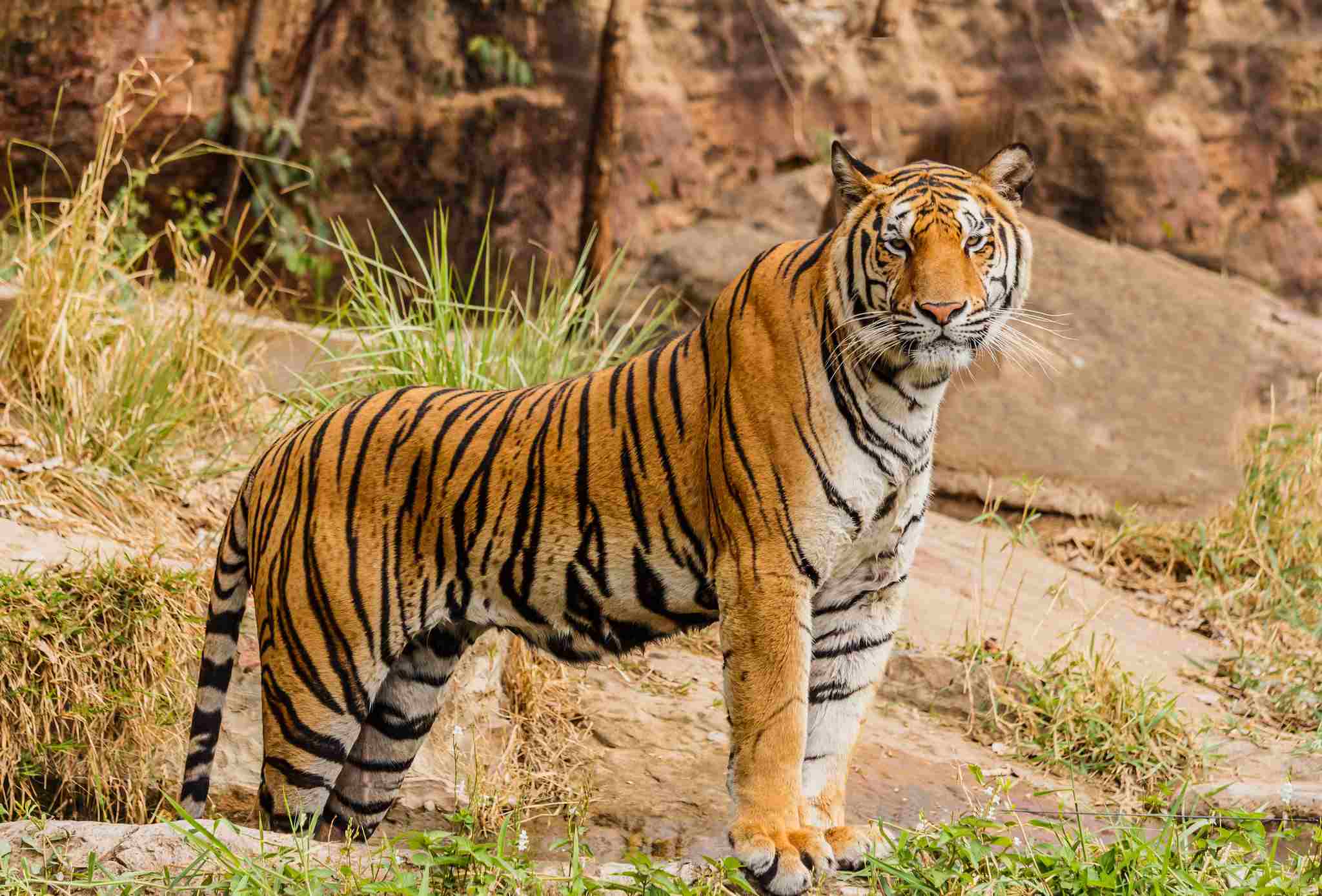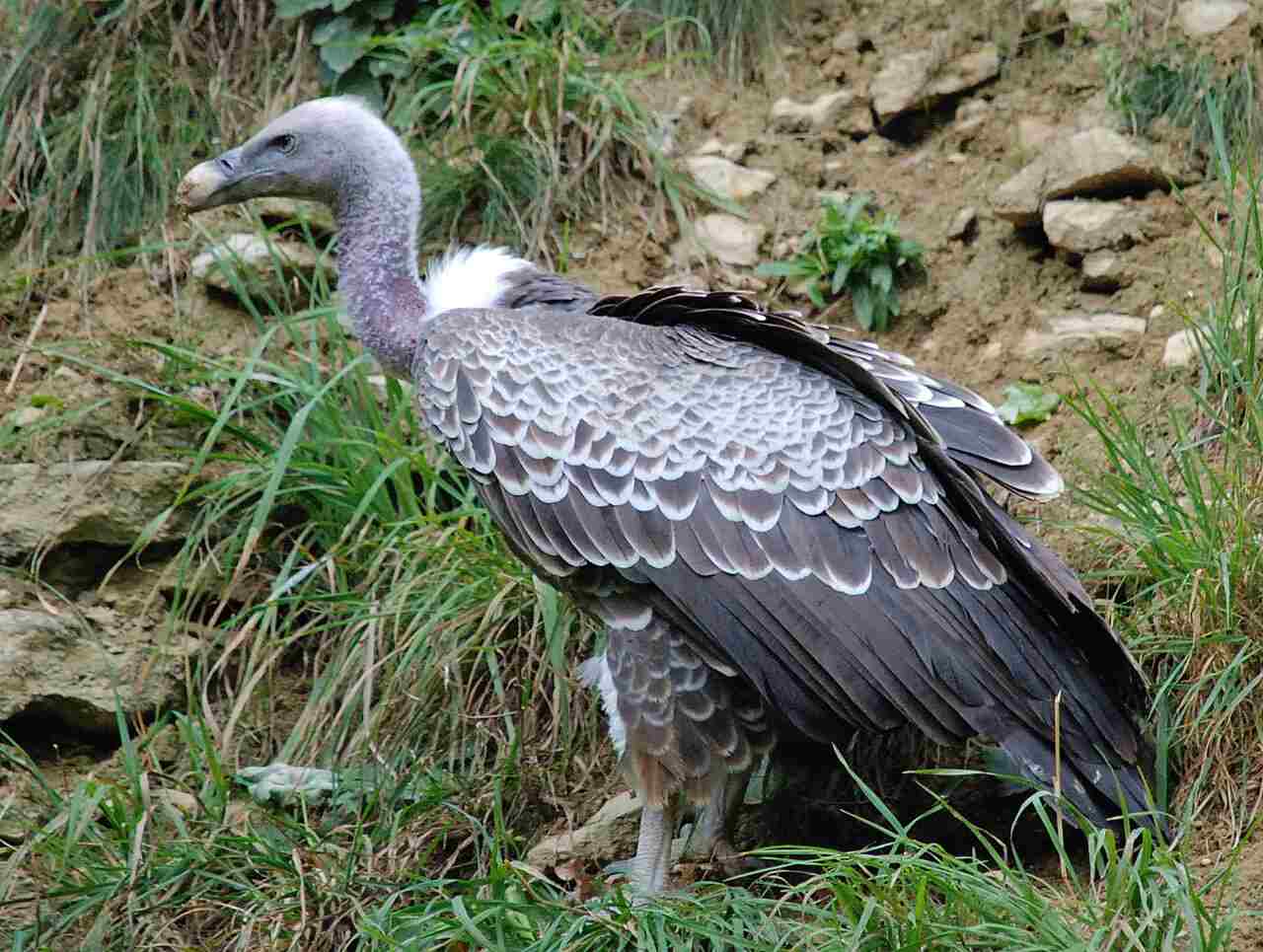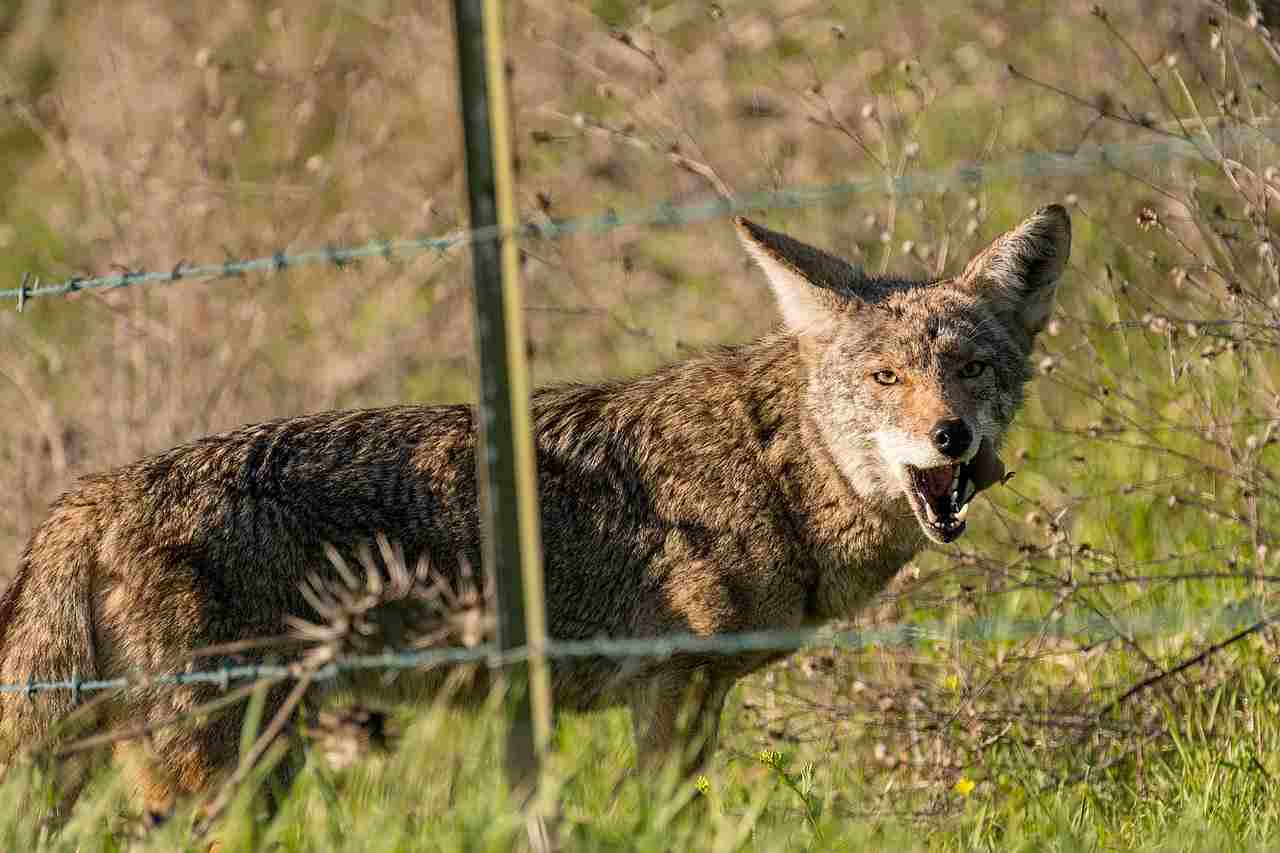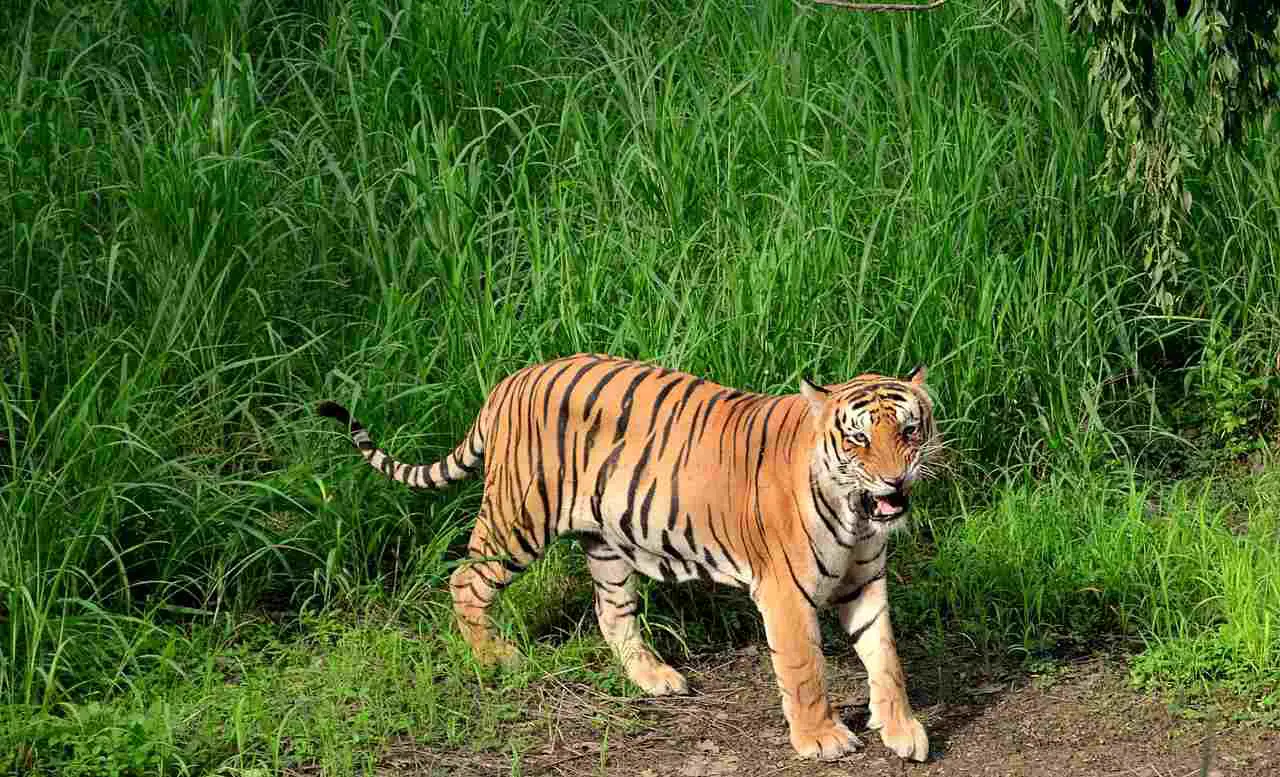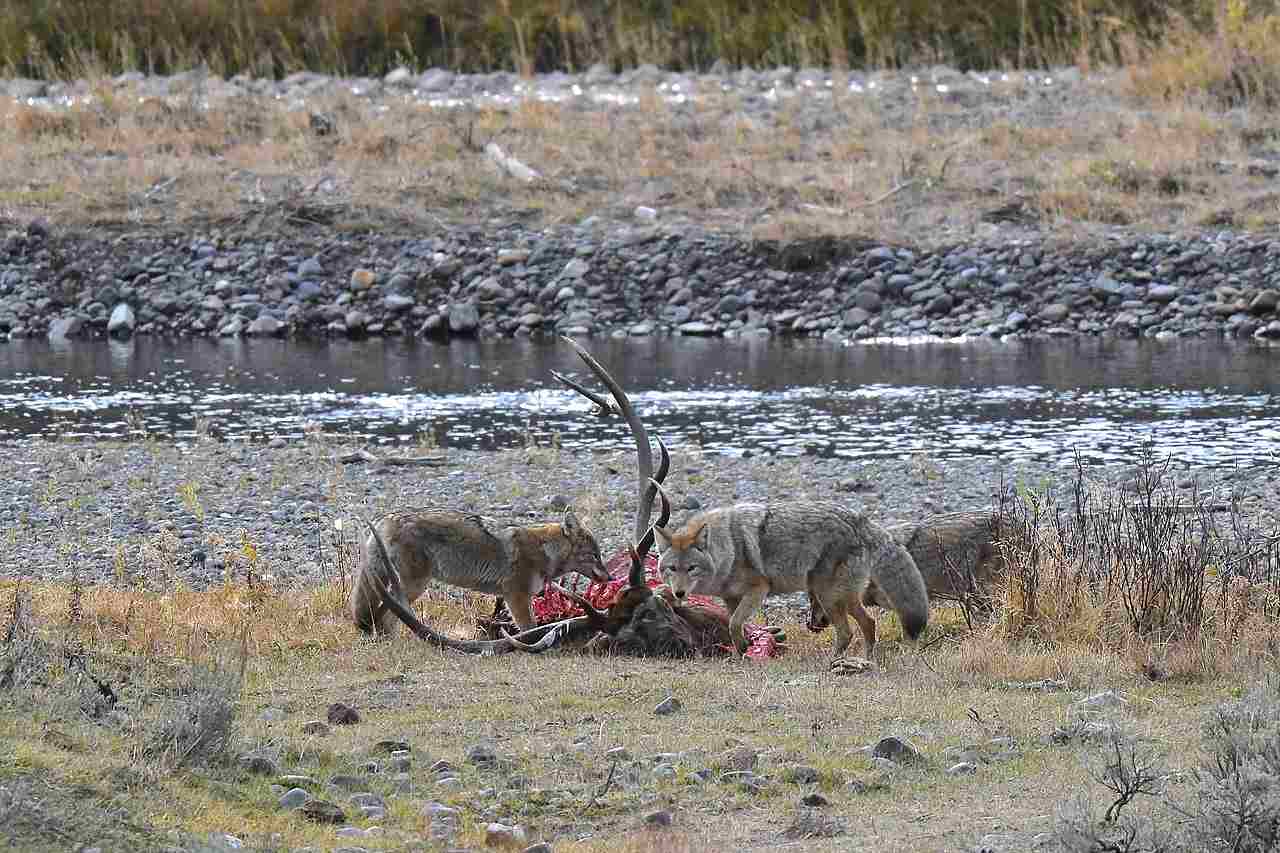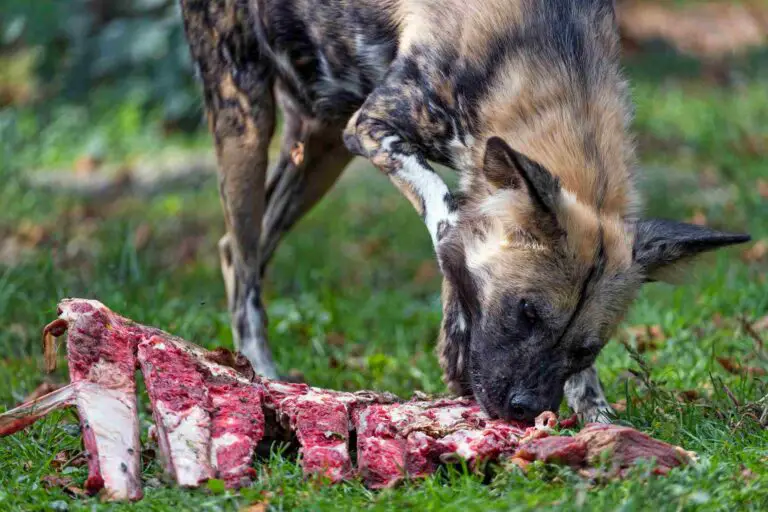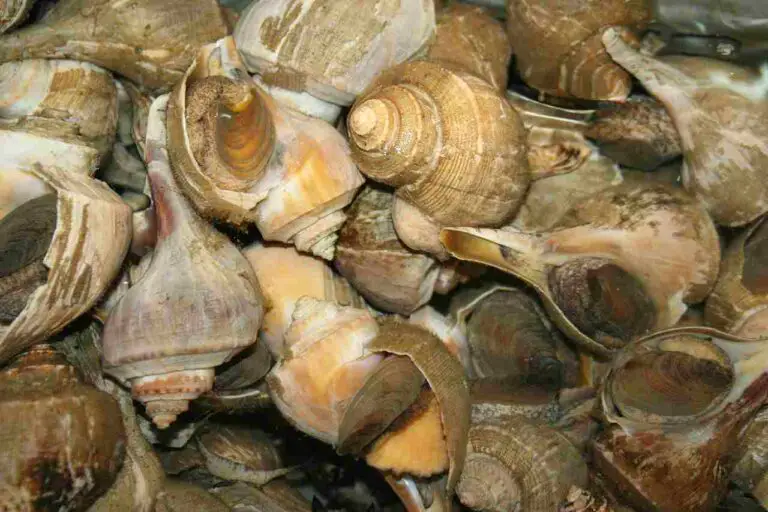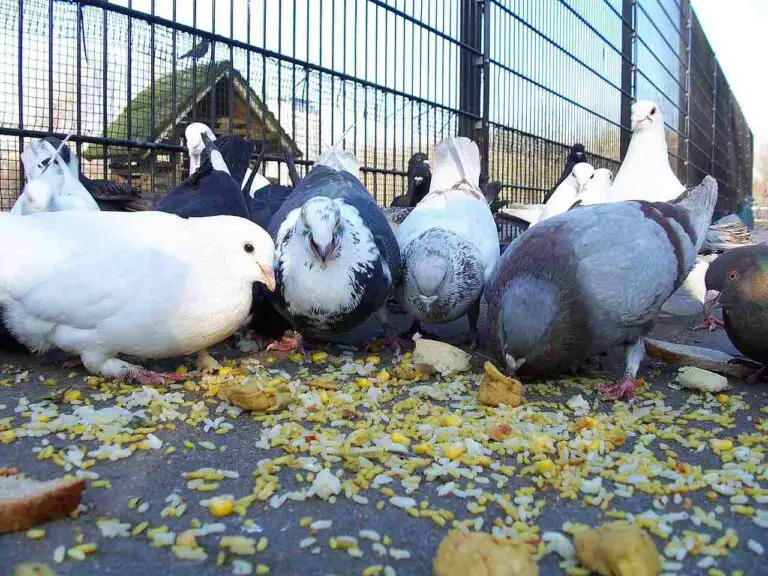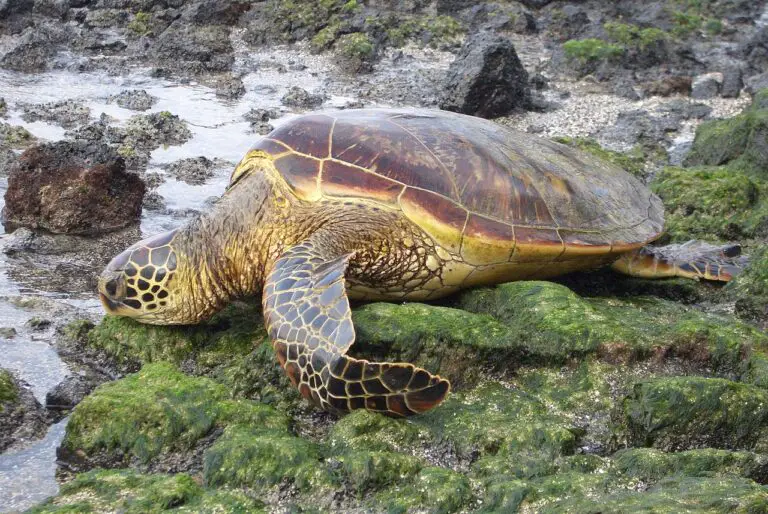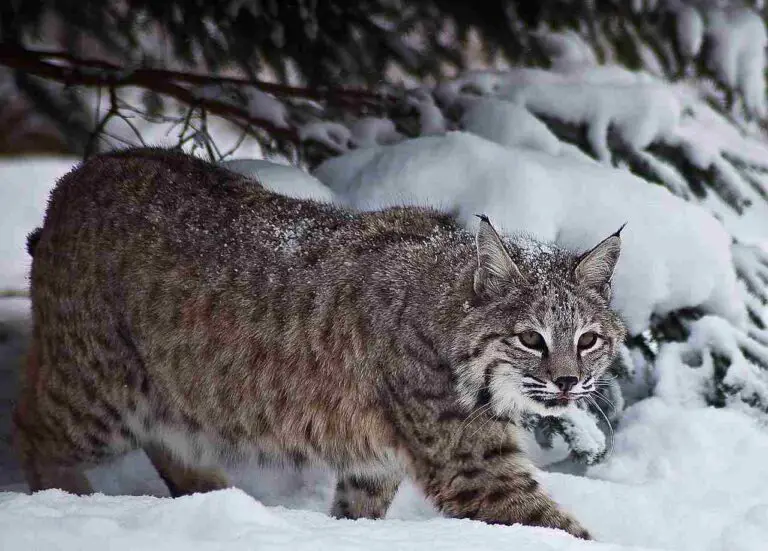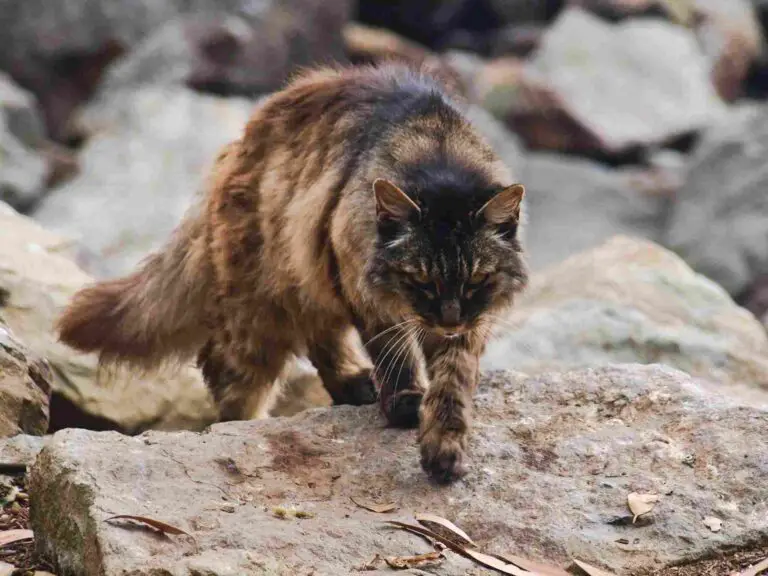What Animal Eats Wolves? 7+ Predators of Wolves Discussed
Animals that eat wolves include; polar bears, grizzly bears, black bears, Siberian tigers, vultures, coyotes, eagles, and humans.
These predators and consumers differ vastly in their ecological range, feeding habits, and circumstances of wolf predation.
It must be noted that the wolf is an apex predator tat faces no natural threat of predation, and mostly becomes a food source for other organisms under unusual circumstances. Other wolves may also feed on the carcasses of dead wolves, but this is extremely rare.
What Eats Wolves in the Forest?
In the forest, wolves face a few predators that may consider them as prey. One of these predators is the Siberian tiger, which, although not a natural predator of wolves, may kill and eat them under certain circumstances. In parts of the world where the Siberian tiger and wolves inhabit the same ecosystem, competition for resources like prey and territory can lead to the tiger preying on wolves. However, it is important to note that documented cases of Siberian tigers killing wolves are more common than cases of them actually consuming the wolves.
Another predator that poses a threat to wolves in the forest is the eagle. Eagles are known to prey on wolves, particularly in the taiga biome. The taiga, which includes temperate deciduous, boreal, and temperate rainforests, is home to various scavengers that may also feed on wolf carcasses. However, bears and eagles are the main predators that may actively hunt and eat wolves in this habitat.
1). Siberian Tiger
The Siberian tiger, although not a natural predator of wolves, may kill and eat them in the forest under certain circumstances. In parts of the world where the Siberian tiger and wolves inhabit the same ecosystem, there can be competition for resources such as prey and territory, which can lead to the tiger preying on wolves. However, it is important to note that while there are documented cases of Siberian tigers killing wolves, cases of them actually consuming the wolves are less common.
Another predator that poses a threat to wolves in the forest is the eagle. Eagles are known to prey on wolves, particularly in the taiga biome. The taiga, which includes temperate deciduous, boreal, and temperate rainforests, is home to various scavengers that may also feed on wolf carcasses. However, bears and eagles are the main predators that may actively hunt and eat wolves in this habitat.
In the forest, the Siberian tiger is an animal that preys on wolves. Although it is not their natural prey, the tiger may kill and eat wolves when they inhabit the same ecosystem. This usually occurs due to competition for resources such as prey and territory. While there are documented cases of Siberian tigers killing wolves, it is more common for them to kill the wolves without actually consuming them.
Similarly, eagles are known to prey on wolves in the forest, especially in the taiga biome. Wolves, particularly vulnerable and unprotected juveniles, may fall victim to eagles. While eagles primarily feed on other prey, they may occasionally target wolves when the opportunity arises.
2). Eagle
Eagles are formidable predators that pose a threat to wolves in the forest, particularly vulnerable and unprotected juveniles. While it is rare for eagles to prey on adult wolves, they may occasionally target them when the opportunity arises. Eagles have sharp talons and powerful beaks, which they use to kill and prey on their victims.
These majestic birds of prey are known for their exceptional eyesight, allowing them to spot potential prey from great distances. Once an eagle identifies a wolf as a potential target, it will swoop down from the sky with incredible speed and accuracy. Using its sharp talons, the eagle will latch onto the wolf, inflicting fatal injuries.
While eagles primarily feed on other prey, such as small mammals and fish, they may opportunistically prey on wolves in the forest. This behavior is more common in areas where wolves and eagles share the same habitat, such as the taiga biome. In this vast forested region, eagles have ample opportunities to hunt and feed on vulnerable wolf pups or injured individuals.
3). Grizzly Bear
Grizzly bears are another formidable predator that poses a threat to wolves in the forest. As a larger predator, grizzly bears have the advantage of size and strength, making them a formidable opponent for wolves. They have a wide range and may overall territory, which often overlaps with wolf habitats. This proximity increases the chances of encounters between the two species.
Grizzly bears are known to be opportunistic hunters and scavengers, and they may kill wolves for competitive purposes. When resources are scarce, such as during times of food scarcity or when defending their territory, grizzly bears may see wolves as competition and eliminate them to secure their own survival. This behavior is more common in areas where food sources are limited, forcing predators to compete for resources.
While grizzly bears have a varied diet, their preferred prey includes ungulates such as elk, moose, and deer. However, they are known to prey on smaller animals as well, including wolves. Grizzly bears have powerful jaws and sharp claws, which they use to overpower their prey. They are capable of inflicting fatal injuries on wolves, especially if they catch them off guard or when the wolves are in a weakened state.
In addition to direct predation, grizzly bears may also scavenge on wolf kills. When wolves successfully hunt and make a kill, they may not be able to consume the entire carcass. Grizzly bears, with their keen sense of smell, can detect the scent of a fresh kill from miles away and will opportunistically feed on the remains. This scavenging behavior allows grizzly bears to benefit from the wolves’ hunting efforts without having to engage in direct confrontation.
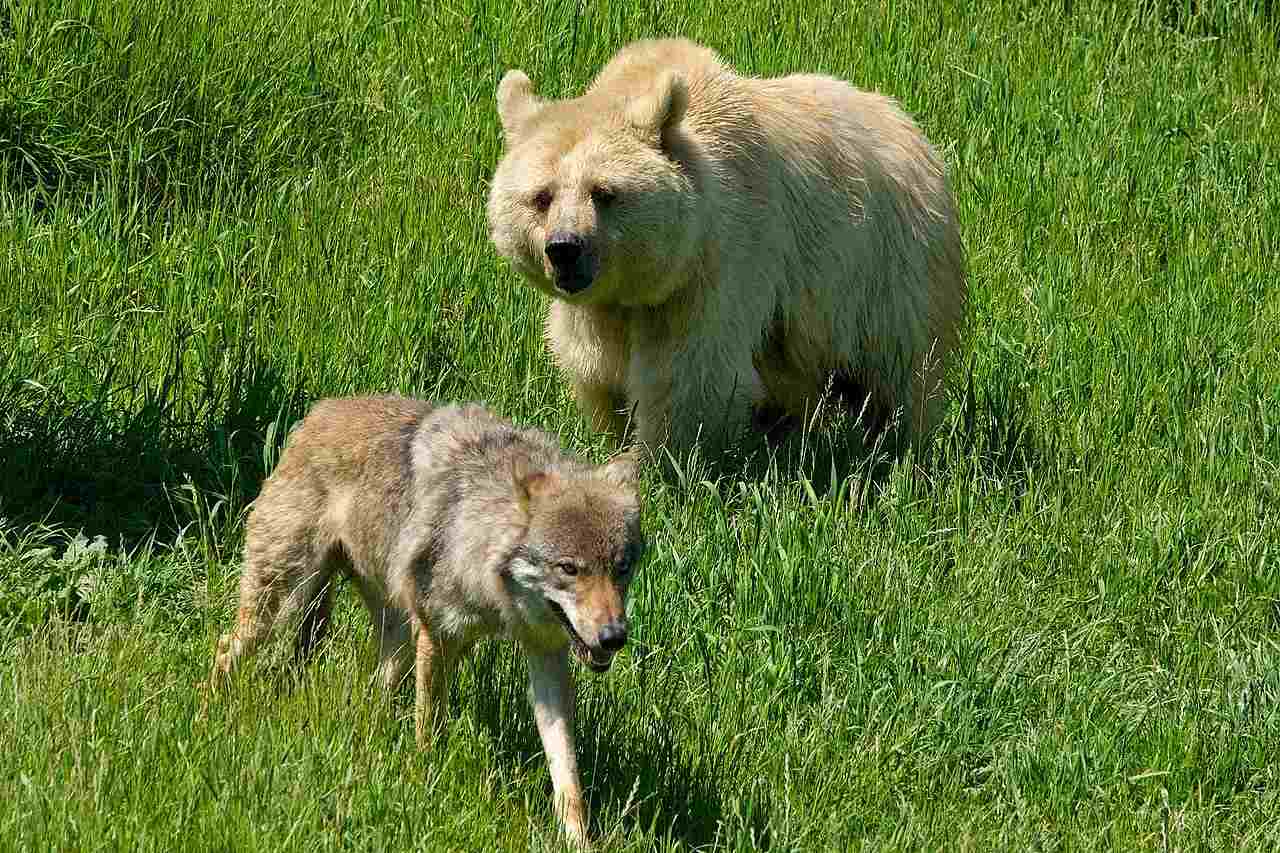
4). Black Bear
Black bears are another predator that can pose a threat to wolves in the forest. These large mammals are known for their strength and agility, making them formidable opponents for wolves. Black bears have a wide range and can be found in various habitats, including forests where wolves reside. This overlap in territory increases the likelihood of encounters between the two species.
While black bears are primarily omnivorous, feeding on a variety of plant matter, they are also opportunistic hunters. They have been known to prey on smaller animals, including wolves, especially when other food sources are scarce. Black bears have sharp claws and powerful jaws that they can use to overpower their prey. In a confrontation between a black bear and a wolf, the bear’s size and strength give it an advantage.
In addition to direct predation, black bears may also scavenge on wolf kills. When wolves successfully hunt and make a kill, they may not be able to consume the entire carcass. Black bears, with their keen sense of smell, can detect the scent of a fresh kill and will opportunistically feed on the remains. This scavenging behavior allows black bears to benefit from the wolves’ hunting efforts without having to engage in direct confrontation.
It’s important to note that while black bears can be a threat to wolves, they are not solely focused on hunting them. Black bears have a diverse diet that includes berries, nuts, insects, and other small mammals. They are more likely to target wolves when they perceive them as a potential source of food or when they feel threatened.
5). Scavengers
Scavengers play an important role in the ecosystem by feeding on the remains of dead animals. In the forest, there are several scavengers that may come across the carcass of a wolf and take advantage of the opportunity for a meal. Blowflies, crows, possums, badgers, and foxes are among the scavengers that feed on the remains of animals. While these scavengers do not actively hunt and kill wolves, they can still benefit from the presence of a wolf carcass.
Blowflies are insects that lay their eggs on decaying flesh, and their larvae, known as maggots, feed on the decomposing tissue. Crows are highly intelligent birds that are known to scavenge on carrion, including the remains of wolves. Possums, badgers, and foxes are opportunistic feeders that will consume the remains of dead animals when they come across them.
It’s important to note that these scavengers do not pose a direct threat to live wolves. They are simply taking advantage of the available food source. While wolves are generally apex predators in the forest, they can also become part of the food chain after their death. The presence of scavengers helps to break down the carcass and recycle nutrients back into the ecosystem.
What Eats Wolves in the Desert?
In the desert, wolves face a different set of predators. Lions, cougars, coyotes, and vultures are among the animals that may prey on wolves in arid regions. While the habitats of wolves and these predators may not always overlap, there are instances where wolves may fall victim to them.
In Africa and Asia, where some wolf species are found, lions can pose a threat to wolves if there is competition for food or scarcity of resources. However, lions typically prefer to eat other prey and may only resort to hunting and consuming wolves under certain circumstances. Cougars, coyotes, and vultures are also known to target wolves in the desert, taking advantage of any opportunity for a meal. These predators play a crucial role in maintaining the balance of the ecosystem, ensuring that no single species becomes too dominant.
1). Lions
In arid regions of Africa and Asia, wolves may fall prey to a variety of predators. While the habitats of wolves and these predators may not always overlap, there are instances where wolves may become victims. In these regions, the African golden wolf and various Asian wolf species are found.
Among the predators that pose a threat to wolves in the desert, lions are one of the notable ones. If there is competition for food or scarcity of resources, lions may kill and eat wolves. However, lions typically prefer to eat other prey and only resort to hunting and consuming wolves under certain circumstances. They are an animal that occasionally preys on wolves in the desert, but they will generally prefer to eat their preferred prey.
2). Cougars
Cougars, also known as mountain lions, are another predator that occasionally preys on wolves in the desert. While it is rare, cougars may target juvenile, injured, or sick adult wolves. However, due to the pack behavior of wolves, these interactions are infrequent. Cougars typically prefer to prey on smaller animals, such as deer or smaller mammals, rather than wolves.
Interestingly, the relationship between cougars and wolves can be complex. In some cases, wolves may also prey on cougars or scavenge their carcasses. This can occur under certain conditions, such as when there is a scarcity of food or resources. These interactions between cougars and wolves highlight the intricate dynamics of predator-prey relationships in the desert ecosystem.
3). Coyotes
Coyotes are highly opportunistic predators in the desert ecosystem. They especially feed on young or other vulnerable animals, making them potential predators of wolves. While coyotes primarily hunt smaller prey, they may also scavenge carcasses, including those of wolves. However, it is rare for coyotes to actively prey on adult wolves.
Interestingly, the relationship between wolves and coyotes in the desert is complex. It is more common for wolves to prey on coyotes or scavenge their carcasses. This can occur when there is a scarcity of food or resources, leading to increased competition between the two species. These interactions highlight the intricate dynamics of predator-prey relationships in the desert.
4). Vultures
Vultures play a crucial role in the desert ecosystem as scavengers, and they are known to feed on the remains of various animals, including wolves. These birds have a keen sense of smell that allows them to detect carcasses from great distances. When vultures come across the remains of a wolf in the desert, they will gather in large numbers to feed on the carcass.
As scavengers, vultures provide an important service by cleaning up the environment and preventing the spread of disease. They efficiently consume the flesh of dead animals, leaving behind only bones and other non-edible parts. This helps to maintain the balance of the ecosystem and recycle nutrients back into the environment.
It’s worth noting that vultures primarily feed on carrion and are not typically active predators. They rely on finding already deceased animals rather than actively hunting live prey. Therefore, while vultures may scavenge the remains of wolves in the desert, they are not considered direct predators of wolves.
What Eats Wolves in the Tundra?
In the harsh and unforgiving environment of the tundra, where the temperatures are freezing and the landscape is vast and barren, wolves face unique challenges and predators. While wolves are apex predators in the Arctic and other tundra regions, there are still a few animals that can pose a threat to them.
One of the main predators of wolves in the tundra is the polar bear. As the largest land predator in the world, polar bears have the strength and size to take down a wolf if necessary. However, it’s important to note that polar bears primarily prey on seals and other marine mammals. Wolves are not a typical part of their diet and are only targeted in severe cases of food scarcity.
Another predator that may consume wolves in the tundra is the golden eagle. These majestic birds of prey have a keen eyesight and powerful talons, making them formidable hunters. While they primarily feed on smaller mammals and birds, golden eagles have been known to scavenge on carcasses, including those of wolves.
In the vast expanse of the tundra, where resources are scarce, wolves must also contend with the challenges of finding enough food to survive. They rely on their hunting skills and pack dynamics to take down prey such as caribou and muskoxen. However, in times of food scarcity or when weakened by other factors, wolves may become vulnerable to predation by other animals.
What Eats Wolves in the Wild?
In the wild, wolves face a range of potential predators, although their status as apex predators means that they are not commonly preyed upon. However, there are certain conditions under which wolves may fall victim to other animals in their ecosystem.
One of the main predators of wolves in the wild is the bear. Both grizzly bears and black bears have been known to prey on wolves, especially when they are weakened or vulnerable. Bears have the size and strength to overpower a wolf, making them a formidable threat.
Another potential predator of wolves in the wild is the mountain lion, also known as the cougar. These solitary and stealthy predators are skilled hunters and can take down prey larger than themselves. While wolves are not a primary food source for mountain lions, they may become targets if they are injured or isolated from their pack.
Coyotes, although smaller than wolves, can also pose a threat to them. In some cases, coyotes may target wolf pups or individuals that are sick or injured. Their ability to work in packs and their opportunistic nature make them a potential danger to wolves in certain situations.
Birds of prey, such as eagles and vultures, may scavenge on wolf carcasses, especially if the wolves have died from natural causes or have been killed by other predators. These birds play an important role in the ecosystem by cleaning up carrion and preventing the spread of disease.
What Eats Wolves in the Food Chain?
In the food chain, wolves are considered apex predators, meaning they have no natural predators. However, under certain conditions, some tertiary and quaternary consumers may feed on wolves. One such predator is the grizzly bear, which has been known to prey on wolves, especially when they are weakened or vulnerable. Another potential predator in the food chain is the polar bear, which shares similar habitat with wolves in the Arctic regions.
The mountain lion, also known as the cougar, is another predator that may feed on wolves in certain situations. While wolves are not a primary food source for mountain lions, they may become targets if they are injured or isolated from their pack.
Interestingly, humans can also feed on wolves. As the ultimate apex predators with advanced intelligence and tools, humans have the ability to hunt and consume wolves. However, it’s important to note that human predation on wolves is not a common occurrence and is regulated in many regions.
What Eats Wolves and Coyotes?
Wolves and coyotes are both top predators in their respective ecosystems, but they are not without their own predators. In the same ecosystems where wolves and coyotes are found, there are several other animals that may prey on them.
One such predator is the bear. Both grizzly bears and black bears have been known to hunt and feed on wolves and coyotes. Bears are powerful and opportunistic predators, and if given the chance, they will not hesitate to take advantage of a weakened or vulnerable wolf or coyote.
Another predator that may target wolves and coyotes is the mountain lion, also known as the cougar. While wolves and coyotes are not the primary prey for mountain lions, they may become targets if they are injured or isolated from their pack. Mountain lions are stealthy and agile hunters, making them a formidable threat to both wolves and coyotes.
In addition to bears and mountain lions, vultures can also play a role in the scavenging of wolf and coyote carcasses. Vultures are specialized scavengers that feed on carrion, including the remains of wolves and coyotes. They play an important ecological role in cleaning up the environment by consuming dead animals.
It’s important to note that while these predators may occasionally prey on wolves and coyotes, they are not their primary food source. Wolves and coyotes have evolved to be highly adaptable and skilled hunters, and they are able to defend themselves against most predators. However, in certain situations, such as when they are weakened or isolated, they may become vulnerable to predation.
Predators of Arctic Wolves
Arctic wolves, also known as white wolves, inhabit the harsh and unforgiving Arctic regions. In this extreme environment, they face formidable predators that have adapted to survive in these icy landscapes. The two main predators of Arctic wolves are the polar bear and humans.
The polar bear, the largest land predator on Earth, poses a significant threat to Arctic wolves. With their immense size and strength, polar bears are capable of overpowering even the most skilled and resilient wolves. They are excellent swimmers and can easily traverse the icy waters to reach the wolves’ territories. When food is scarce, polar bears may actively hunt Arctic wolves, considering them as a potential source of sustenance.
Humans, particularly indigenous communities and hunters, also play a role in the predation of Arctic wolves. For centuries, humans have relied on wolves for fur, food, and cultural practices. While hunting wolves is regulated in many regions, conflicts between humans and wolves still occur. In some cases, wolves may be seen as a threat to livestock or game animals, leading to targeted hunting efforts.
It’s important to note that the relationship between humans and Arctic wolves is complex. While some humans pose a threat to the wolves, others actively work to protect and conserve their populations. Conservation organizations and researchers are dedicated to studying and preserving Arctic wolves, recognizing their ecological importance and the need for their survival in the fragile Arctic ecosystem.
Conclusion
* In conclusion, this article has explored the various predators of wolves in different environments, including the forest, desert, and tundra. We have discussed the threats that Arctic wolves face from polar bears and humans, as well as the complex relationship between humans and wolves.
* Throughout this article, we have highlighted the importance of understanding the predators of wolves in order to appreciate the challenges these magnificent creatures face in their natural habitats. By examining the predators of wolves, we gain insight into the delicate balance of ecosystems and the interconnectedness of species within them.
* The forest is home to several predators that pose a threat to wolves. The Siberian tiger, with its strength and agility, is one such predator. Eagles, known for their keen eyesight and aerial hunting skills, also target wolves as potential prey. Additionally, grizzly bears and black bears are formidable predators that can overpower wolves in confrontations. Even scavengers, such as hyenas and vultures, play a role in the ecosystem by feeding on wolf carcasses.
* In the desert, where resources are scarce, wolves face a different set of predators. Lions, known for their strength and cooperative hunting strategies, are capable of taking down wolves. Cougars, with their stealth and agility, are also skilled predators that can prey on wolves. Coyotes, although they share a similar habitat with wolves, can also pose a threat, especially when competing for limited resources. Vultures, as scavengers, play a role in the desert ecosystem by feeding on the remains of dead wolves.
* The tundra, with its harsh and unforgiving conditions, presents unique challenges for wolves. While the specific predators of wolves in the tundra were not discussed in this article, it is important to recognize that the extreme cold and limited resources make survival difficult for all species, including wolves.
* In the wild, wolves face a variety of predators depending on their location and habitat. Understanding the predators of wolves helps us appreciate the complex dynamics of predator-prey relationships and the role each species plays in maintaining the balance of ecosystems.
* The food chain is a crucial concept to consider when discussing the predators of wolves. Wolves, as apex predators, play a vital role in regulating prey populations and maintaining the overall health of ecosystems. By controlling the populations of herbivores, wolves prevent overgrazing and help maintain the balance of plant and animal life.
* Wolves and coyotes share similar habitats and often compete for resources. While wolves are larger and more powerful, coyotes are adaptable and can thrive in a variety of environments. Both species play important roles in their respective ecosystems, and their interactions can have significant impacts on the balance of predator and prey populations.
* The predators of wolves are diverse and varied, reflecting the complex web of life in different environments. Understanding these predators is essential for conservation efforts and the preservation of wolf populations. By protecting wolves and their habitats, we can ensure the continued existence of these magnificent creatures and maintain the delicate balance of ecosystems they inhabit.
FAQs
1. What Predator Eats Wolves?
Wolves, despite being apex predators themselves, are not exempt from being preyed upon by other animals. One of the main predators of wolves is the bear. Bears, including grizzly, black, and polar bears, have been known to hunt and kill wolves. These powerful and opportunistic predators have the strength and size to overpower wolves and are not afraid to take advantage of a vulnerable moment.
Bears are highly adaptable and can thrive in various habitats, from forests to tundras. They possess sharp claws and powerful jaws, making them formidable hunters. While wolves are known for their pack mentality and cooperative hunting strategies, they can still fall victim to a bear’s strength and aggression.
2. What are Arctic Wolves’ Predators?
Arctic wolves, despite their harsh and remote habitat, do have predators. One of the main predators of Arctic wolves is the polar bear. These massive bears are well-adapted to the Arctic environment and have the strength and size to overpower wolves. With their powerful paws and sharp claws, polar bears can easily take down an Arctic wolf.
Another predator of Arctic wolves is humans. While not a natural predator, human activities such as hunting and habitat destruction pose a significant threat to Arctic wolves. Illegal hunting and climate change have led to a decline in Arctic wolf populations, making them vulnerable to human predation.
3. What Animal Kills and Eats Wolves?
Wolves, despite being apex predators themselves, can fall victim to other animals in certain circumstances. One of the main animals that kills and eats wolves is the bear. Bears, such as grizzly bears and black bears, have the size and strength to overpower wolves and can prey on them if the opportunity arises. Additionally, large felines like lions have been known to kill and eat wolves, especially when they are juveniles and more vulnerable.
In addition to bears and lions, some raptors can also prey on juvenile wolves. Eagles, with their powerful talons and sharp beaks, are capable of hunting and consuming young wolves. These predators take advantage of the wolves’ smaller size and relative inexperience to secure a meal.
4. What Eats Wolves When They’re Dead?
When wolves die, they become a valuable source of food for various scavengers. Vultures, with their keen eyesight and powerful beaks, are often the first to spot a dead wolf and will quickly gather to feed on the carcass. These birds of prey play a crucial role in the ecosystem by efficiently disposing of animal remains.
Crows, known for their intelligence and adaptability, are also attracted to dead wolves. They scavenge for any remaining scraps of meat or carrion that the vultures may have missed. Coyotes, opportunistic predators and scavengers, will also take advantage of a deceased wolf, feeding on the remains to sustain themselves.
In addition to these scavengers, eagles are known to feed on dead wolves. With their sharp talons and powerful beaks, eagles can tear into the carcass and extract meat for consumption.
5. What Kind of Animal Eats Wolves?
When it comes to what kind of animal eats wolves, the answer lies in the category of opportunistic predators or scavengers. Wolves are not typical prey for many animals, but there are a few that may take advantage of a weakened or deceased wolf.
One such animal is the grizzly bear. These powerful creatures have been known to prey on wolves, especially if they come across a lone or injured individual. Grizzly bears have the strength and size to overpower a wolf and feed on its carcass.
Another potential predator of wolves is the Siberian tiger. These majestic big cats are skilled hunters and have been observed hunting and killing wolves in their natural habitat.
6. What is the Biggest Threat to Arctic Wolves?
The biggest threat to Arctic wolves is undoubtedly humans. Human activities have a significant impact on the Arctic ecosystem, which directly affects the survival of these magnificent creatures. Climate change, caused by human-induced greenhouse gas emissions, is altering the Arctic environment at an alarming rate. The melting of sea ice and the loss of permafrost disrupt the wolves’ habitat and food sources, making it increasingly challenging for them to find prey.
Furthermore, habitat degradation due to industrial development, such as oil and gas exploration, mining, and infrastructure construction, further threatens the Arctic wolves’ survival. These activities destroy the wolves’ natural habitat, fragment their territories, and limit their access to prey.
In addition to habitat destruction, humans may also directly hunt Arctic wolves. Although hunting regulations exist in some regions, illegal hunting and poaching still pose a significant threat to their population.
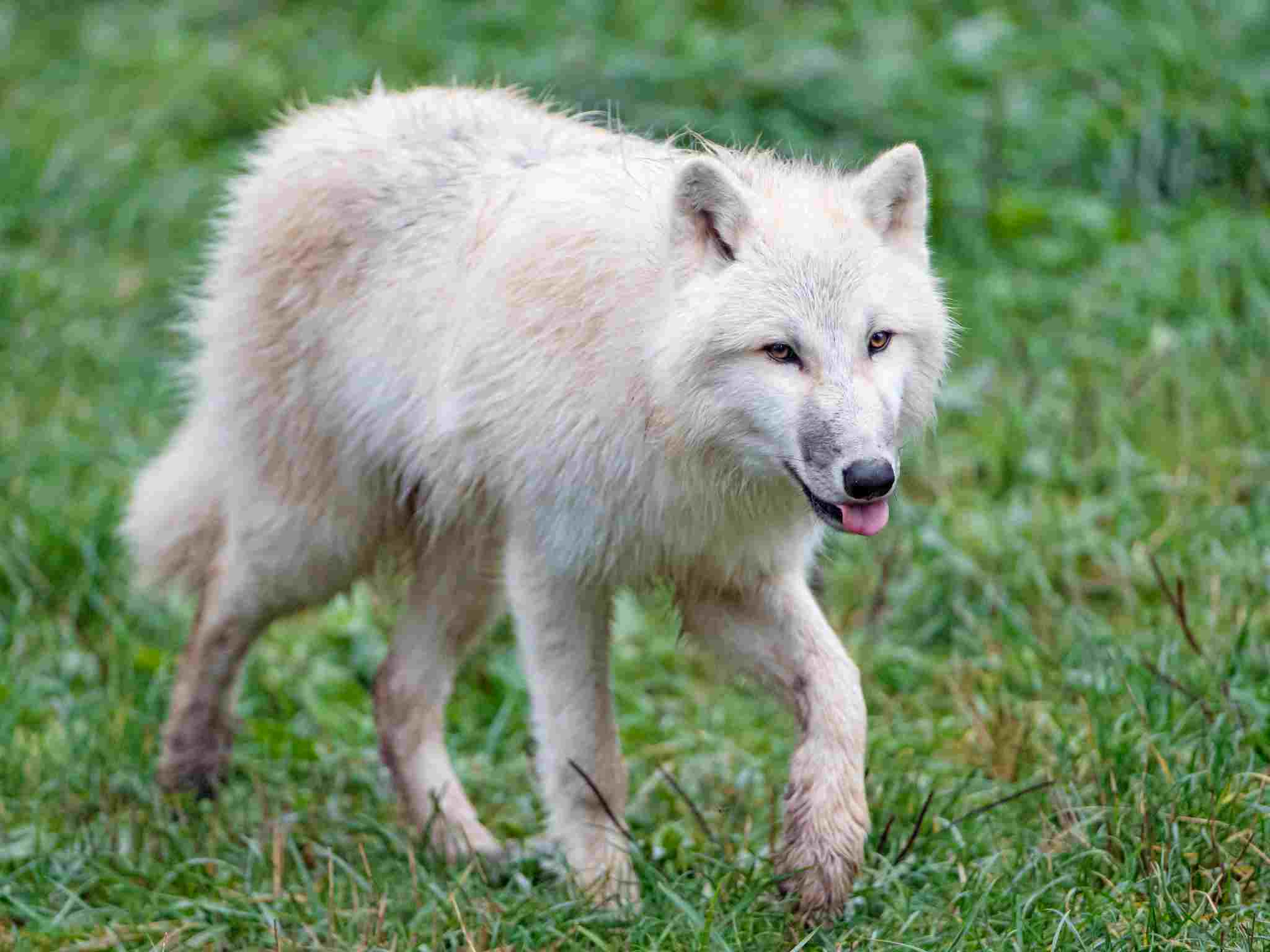
7. What are The Predators of The Wolf?
The wolf, despite being a formidable predator itself, does have natural enemies in certain ecosystems. In the forest, the Siberian Tiger is one of the top predators that can pose a threat to wolves. With its size and strength, the tiger can overpower a wolf in a confrontation. Eagles, known for their aerial hunting skills, can also be predators of wolves, especially when they are young or injured.
In the desert, wolves may face predators such as lions, cougars, and coyotes. These predators have adapted to the harsh desert environment and can compete with wolves for resources. Vultures, known for scavenging, can also prey on weak or injured wolves.
While wolves are not typically found in the tundra, if they were, they would face challenges from larger predators like polar bears and Arctic foxes. These predators are well-adapted to the extreme cold and have the advantage of camouflage in the snowy landscape.
8. Are Arctic Wolves Hunted?
Arctic wolves are indeed hunted, but not by other animals in their ecosystem. Instead, they face the threat of being actively hunted by humans for their fur and as trophies. The beautiful white coat of the Arctic wolf makes it a prized target for hunters. These wolves are sought after for their pelts, which are used in the fur trade. Additionally, some individuals hunt Arctic wolves as a form of sport or to display as trophies.
The hunting of Arctic wolves has had a significant impact on their population numbers. Overhunting has led to a decline in their numbers in certain regions. Conservation efforts have been put in place to protect these majestic creatures and regulate hunting practices. However, illegal hunting still poses a threat to their survival.
9. What is the Lifespan of a Arctic Wolf?
The lifespan of an Arctic wolf can vary depending on various factors. On average, Arctic wolves live for about 7 to 10 years in the wild. However, this lifespan may vary with factors such as food availability, competition, and environmental conditions.
Arctic wolves face harsh conditions in their habitat, including extreme cold temperatures and limited food sources. These challenges can impact their overall health and lifespan. Additionally, the presence of predators and the risk of hunting by humans can also affect their survival rate.
Despite these challenges, Arctic wolves have adapted to their environment and developed strategies to survive. They live in close-knit packs, which provide them with protection, cooperation in hunting, and raising their young. These social structures contribute to their ability to thrive in the Arctic wilderness.
10. What is a Wolf’s Worst Enemy?
A wolf’s worst enemy is undoubtedly humans. Humans pose a significant threat to wolf populations through various activities such as hunting, habitat destruction, and conflicts with livestock. This human-wolf conflict has led to a decline in wolf populations worldwide.
Hunting, both legal and illegal, has been a major factor in the decline of wolf populations. Wolves are often targeted due to misconceptions about their impact on livestock and game populations. Additionally, habitat destruction and fragmentation caused by human activities have further reduced suitable wolf habitats.
Furthermore, conflicts with livestock have resulted in retaliatory killings of wolves by farmers and ranchers. These conflicts arise when wolves prey on livestock, leading to economic losses for farmers.
To protect wolf populations, conservation efforts are crucial. Implementing measures such as habitat conservation, responsible hunting practices, and promoting coexistence between wolves and humans can help mitigate the threats faced by wolves and ensure their long-term survival.
11. What Kills Wolves the Most?
Wolves face various threats in their natural habitats, but the most significant threat to their survival is humans. Human activities such as hunting, habitat destruction, and conflicts with livestock have led to a decline in wolf populations worldwide. Wolves are often targeted due to misconceptions about their impact on livestock and game populations. Additionally, habitat destruction and fragmentation caused by human activities have further reduced suitable wolf habitats.
While humans pose the greatest danger to wolves, they are also killed by other predators or large prey. In some cases, wolves may be killed by other top predators like bears or big cats when competing for resources or territory. They may also face danger from large prey animals if a hunt goes wrong.
12. How Do Arctic Wolves Protect Themselves from Predators?
Arctic wolves have developed various strategies to protect themselves from predators in their harsh environment. One of the key ways they ensure their safety is through pack behavior. By living and hunting in packs, they can intimidate and fend off potential threats. This strength in numbers also allows them to take down larger prey.
Their teeth also play a crucial role in self-defense. Arctic wolves have sharp, strong teeth that they use to bite and tear at their enemies. These teeth are essential for hunting and protecting themselves from other predators.
Additionally, Arctic wolves have adapted to their surroundings through camouflage. Their white fur blends in with the snowy landscape, making it difficult for predators to spot them. This natural camouflage helps them stay hidden and avoid detection.
